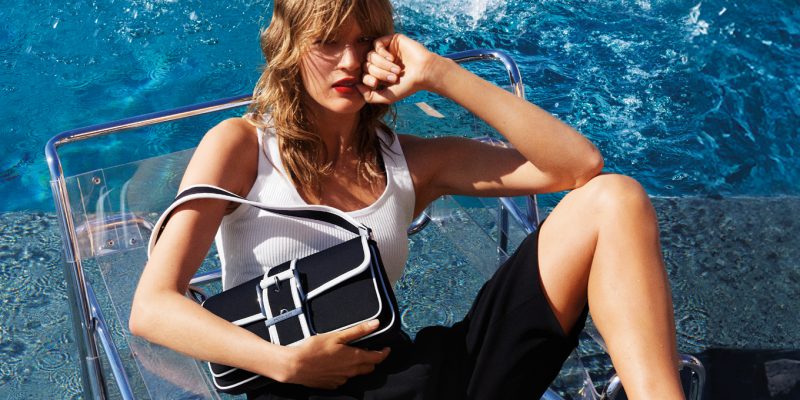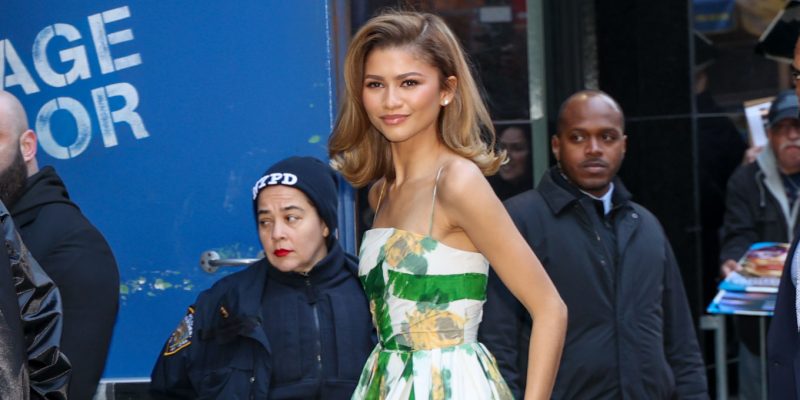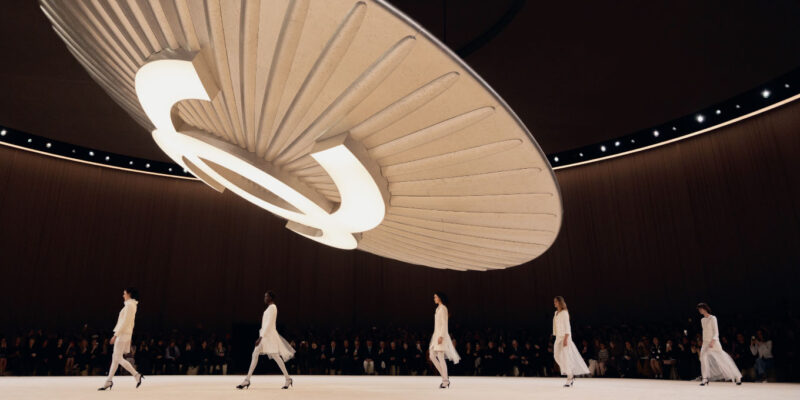Fashion
Pregnant Bellies Are Moving Into the Spotlight
Viva la MILF!
by : Jillian Vieira- Apr 29th, 2024

Getty
There’s a certain collective image we have of the pregnant body: puritanical, angel-adjacent, something to be kept secret and safeguarded save for a sweet announcement. But that’s not really Caroline Vreeland’s style. While pregnant with both of her sons, the Montreal-based singer, content creator and great-granddaughter of the boundary-pushing Vogue editor Diana Vreeland leaned into a decidedly more sensual aesthetic, giving plenty of unapologetically bare airtime to her ever-expanding belly. One memorable example: At a buttoned-up museum fundraiser last November, she shirked the formal dress code in favour of a clingy Maygel Coronel dress with a cut-out that spotlighted the entirety of her nine-months-pregnant belly. Onlookers, both IRL and online among her nearly 500K followers, responded with a healthy mix of gawking and “get it, girl!” sentiments, but for Vreeland, none of that was really the point. “I felt so at the height of my femininity—so powerful and just proud,” she says of her then pregnant shape. “I had zero shame in it—I wanted it on display.”
Vreeland is among a new cohort of bump-baring celebs and influencers who have embraced unabashed visibility throughout pregnancy, revelling in the outness of this symbolic transition to motherhood. One could argue that this recent shift started in early 2022 with Rihanna, whose long-awaited pregnancy notice for her and A$AP Rocky’s first child, RZA, was accompanied by an indelible bare-belly pic showcasing the Chanel-clad singer’s growing middle framed by low-slung jeans and an unbuttoned pink puffer coat. A slew of similarly bold pregnant stars—Sienna Miller, Suki Waterhouse, Vanessa Hudgens and Ciara among them—have since made bump-exposed red-carpet appearances, even though demure, tent-like dresses have long been considered the norm.
This image of a highly confident expectant mom has predictably trickled down to the masses too. On the street-style circuit, unclad bumps have morphed into a must-have, photog-baiting accessory. Over on the mommy-to-be side of Instagram, you’d swear bare bellies were the newly minted account holders: on display at the beach, bathed in beautiful morning light beside a freshly brewed cup of tea and promoting paid collabs (handbags, high-end jewellery, Erewhon smoothies) in all their swollen glory.
Of course, this all-out bump show sits in stark contrast to how our foremothers experienced pregnancy. In Victorian times, they went to great (and sometimes painful) lengths to hide their burgeoning bellies, then considered norm-shattering proof that—gasp!—women actually engaged in sex. According to fashion historian Emily Bach, tightly laced corsetry afforded them weeks or sometimes months of freedom from the expectations of intensive bedrest and societal isolation.
These extreme measures should come as no surprise: Women’s bodies, especially during pregnancy, have long been objects of social control, says Angela Biscaldi, an anthropologist and associate professor in the department of social and political sciences at the University of Milan. “In the West, the pregnant woman’s body has represented submission to patriarchal rule for centuries,” she says. “Pregnancy assigned women to the intimate space of the home.” For so long, superstition and fear swirled around the gestational period, forcing women to remain unseen during the experience. Even in the first half of the 20th century, starlets hid their pregnancies from the public eye as pregnancy was “considered irreconcilable with the world of entertainment but also with a woman’s attractiveness and desirability,” says Biscaldi.
Fast-forward a few decades and an unimaginable image of pregnancy, care of the August 1991 cover of Vanity Fair, completely shocked the tightly wound world: a nude Demi Moore, then expecting daughter Scout Willis, simultaneously cupping her breasts and cradling a third-trimester bump in front of photographer Annie Leibovitz’s lens. The photo shoot elevated pregnancy to an emblem of self-assured sexiness, suggesting that the prenatal period was worthy of deity-like worship. The reaction? About as pearl-clutchingly aghast as you might imagine. Critics called it indecent and scandalous, and the issue was sold on newsstands wrapped in opaque paper, shrouded like its neighbouring pornographic options.
Our socio-cultural conceptions of pregnancy finally began evolving a few years later as sexuality slowly became dissociated from reproductive obligation. Now, kids were desired, and this marked the beginning of an era of intensive, child-centric mothering. In contrast to previous notions that held child-rearing as a gendered duty that was disconnected from how those kids actually turned out, a sweeping idea—which remains pervasive today—posited that “children are the focus of our lives. They are precious and valuable, and we must use all of our time and resources raising the perfect child,” says Andrea O’Reilly, a professor in the School of Gender, Sexuality & Women’s Studies at Toronto’s York University. A child, and by proxy the accompanying pregnancy, became a trophy of sorts. Suddenly, a bump was something to show off: Figure-skimming dresses replaced the de rigueur shapeless sacks, and as the body-positivity movement took root, so, too, did our penchant for unveiling those projecting bellies.
But—because there’s always a “but” with the feminist lens—O’Reilly is quick to identify the potential downsides of this recent visibility. “People didn’t [used to] have permission to surveil pregnant bodies like they do today,” she says, pointing to the unrelenting pressure on and policing of present-day expectant moms. Think about it: There’s the insistence that you diligently take all the right supplements months before you get pregnant, the belief that you should be able to project a carefree, even sexy image throughout the rigours of pregnancy and the unwanted advice from complete strangers—like when one of O’Reilly’s students was told that she should exit a bus shelter for fear of her fetus inhaling exhaust fumes. (Cue the collective eye roll.) “Before, motherhood began after you had the baby,” she says. “Now, you’re a mother even before you become pregnant, and you’re certainly a mother the minute you become pregnant.”
Still, Vreeland, our brazen example of bump-friendliness, and many others are unabashedly embracing this new-found vision of motherhood. For her, joyfully presenting belly-first is a rejection of centuries’ worth of shame—of relegating a woman to feeble, one-note caregiver the second she’s expecting. “She’s not just a mother; she’s not just this dowdy vessel for life,” says Vreeland. “My life did not end when I had my babies. I’m still a woman, I still have passion and I don’t think there’s anything wrong with that. Mommy feels good—viva la MILF!”
Read more:
Every Single Time Rihanna’s Maternity Outfits Redefined Maternity Fashion
Blake Lively’s Best Maternity Looks
Our Beauty Director’s Guide to Pregnancy-Safe Skincare
Newsletter
Join our mailing list for the latest and biggest in fashion trends, beauty, culture and celebrity.
Read Next

Fashion
Reformation Just Launched Sunglasses With French Eyewear Brand Jimmy Fairly
Sourcing chic vintage frames just got easier.
by : Allie Turner- May 15th, 2024

Fashion
Haider Ackermann Is the First-Ever Creative Director of Canada Goose
Plus, actor and activist Jane Fonda partners with the outerwear brand to save the polar bears.
by : Allie Turner- May 15th, 2024

Culture
This Quebec Weekend Itinerary Takes the Scenic Route
The Outaouais has it all.
by : ELLE Canada- May 13th, 2024




